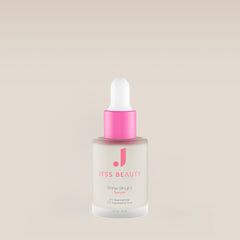The skin, the largest organ in the human body, is a visual testimony to our overall well-being. However, factors such as sun exposure, hormonal changes, and genetic predisposition can trigger the formation of dark spots on the skin, known as hyperpigmentation.
This Jess Beauty article will tell you why these spots form, how to prevent them effectively, and how to differentiate between benign and malignant.
What are dark spots on the skin?

Dark spots on the skin, also known as hyperpigmentation, are areas of the skin that become darker compared to the surrounding tone.
These spots can vary in size and shape and are formed due to an increase in the production of melanin, the pigment responsible for skin, hair, and eye color.
Black spots on the skin are usually quite common and can be generated for different reasons. Here we tell you some of them:
Causes of dark spots
- Sun Exposure: Prolonged, unprotected exposure to the sun can increase melanin production as a skin defense mechanism. It can result in dark spots, such as freckles, solar lentigines (age spots), and melasma.
- Aging: As we age, the production and distribution of melanin in the skin can become irregular, resulting in dark spots known as senile lentigines or age spots.
- Inflammation: Certain inflammatory skin conditions, such as acne, can trigger excessive melanin production in affected areas, which can leave temporary or permanent dark spots after the inflammation subsides.
- Hormonal changes: Hormonal changes like those that occur during pregnancy, menopause, or birth control use can affect melanin production and lead to dark spots, such as melasma (also known as the "mask of pregnancy").
- Skin trauma: Skin injuries, medical procedures, or aggressive cosmetic treatments can trigger a skin response that results in dark spot formation.
- Genetic factors: Genetic predisposition can also influence how the skin responds to sun exposure and other triggers, which can increase the likelihood of developing dark spots.
Benign spots vs. malignant
Not all dark spots on the skin are cause for concern. However, you must be very attentive and be clear about the differences between benign and malignant.
Next, we tell you some aspects that you must take into account to differentiate them:
Asymmetry: Benign spots tend to be symmetrical in shape, while malignant ones can be asymmetrical and uneven.
Regular Borders: Benign spots usually have smooth, regular borders, while malignant ones may have irregular, fuzzy borders.
Uniform Color: Benign spots are usually uniform, while malignant ones can exhibit various colors and shades.
Change and Evolution: If a spot changes in size, shape, or color or presents symptoms such as itching, redness, or bleeding, it is crucial to seek medical attention.
Plus, you should note other aspects such as personal or family history of skin cancer or other skin conditions.
If you have questions or concerns about dark spots on your skin, it is best to consult a dermatologist or health professional. They will be able to examine the spots, make an accurate diagnosis, and recommend the appropriate treatment if necessary.
How to get rid of dark spots

A dark spot removal skincare routine should be consistent and focused on reducing hyperpigmentation while maintaining overall skin health.
Here is a step-by-step guide:
Begin your routine with a gentle yet effective cleanse like Face Reset Cleanser to remove excess oil, dirt, and pollutants that can clog pores and make blemishes worse.
Add a gentle exfoliator to your routine to remove dead skin cells and improve cell renewal. Chemical exfoliants with acids such as glycolic acid or lactic acid can help improve texture and reduce the appearance of blemishes.
Apply a depigmenting serum or cream that contains ingredients like hydroquinone, azelaic acid, vitamin C, or niacinamide. These ingredients can help inhibit melanin production and gradually lighten dark spots. Try Shine Bright Serum by Jess Beauty, formulated with niacinamide.
Sun protection is essential to prevent dark spots from worsening. Use a broad-spectrum sunscreen with SPF 30 or higher, even on cloudy days.
Keep your skin hydrated to maintain a healthy skin barrier. Look for moisturizers with ingredients like hyaluronic acid and glycerin to keep skin balanced and prevent dryness.
Consider dermatological treatments such as lasers, chemical peels, or microdermabrasion to speed up the removal of dark spots. Consult a dermatologist to determine which treatment is right for you.
A balanced diet rich in antioxidants and vitamins can help maintain skin health. Avoid smoking and limit alcohol intake, as these can negatively affect the appearance of the skin.
Dark spot removal takes time and effort. Keep a consistent routine and be patient with the results, as they can take weeks or months to be visible.
Remember that each skin is unique, so it is important to adjust the routine according to your needs and sensitivities.
Always consult a dermatologist before incorporating new products or treatments into your routine, especially if you have pre-existing medical conditions.
Are black dots and dark spots the same?
Black dots or blackheads and dark spots are two different skin conditions, although they can sometimes be confused due to their similar appearance.
Black dots, also known as open comedones, are a form of acne that occurs when skin pores become clogged with sebum, dead skin cells, and other debris. Unlike whiteheads (closed comedones), blackheads have an opening on the skin's surface, allowing it to expose the clogged contents to the air.
Exposure to air and oxidation of cells and sebum trapped in the pore can cause the comedo to turn black or brown.
Black dots are generally not permanent blemishes but temporary accumulations that can be removed through proper cleansing and a good skincare routine.
Try Jess Beauty Face Ritual Bundle to remove blackheads and achieve radiant skin.










